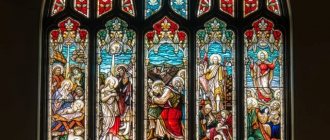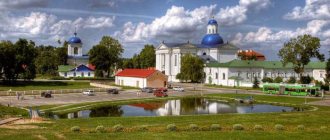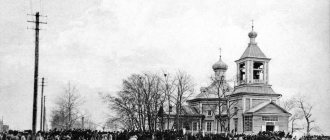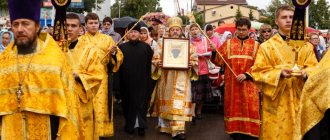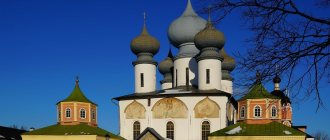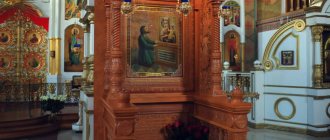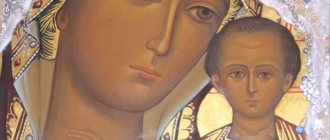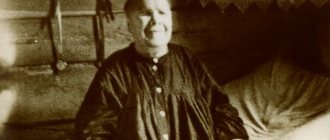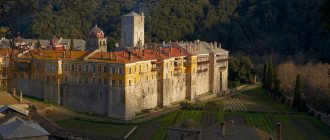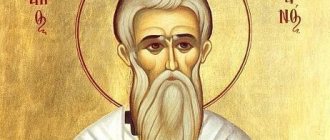The Golden Hair of an Angel is an icon from the 12th century. This is a unique creation by an unknown icon painter, made in the Byzantine style using a rare written form. Due to their uniqueness, there are about twenty such icons in the world. The icon belongs to the masterpieces of world art. The authorship of his style can be attributed to the Novgorod masters in the painting of the Transfiguration Church in Nederitsa. It was discovered by historian G.D. Filimonov in the second half of the 18th century in the Kremlin on the bell tower among objects to be destroyed as useless garbage. Most likely, the icon came to the Kremlin in the 16th century under Ivan the Terrible. The icon of Golden Vlasa has survived to this day in a dilapidated state and already in a changed, rewritten form. It is not known for certain where the icon of the Angel with golden hair used to be. It is believed that this image was in the iconostasis of one of the Novgorod churches. Modern restorers have discovered traces of 18th-century restorations.
The history of the creation of the holy face
To this day, very few monuments from the beginning of the Old Russian icon-painting period have survived to say with certainty which school the “Angel” belongs to. Researchers put forward several of the most likely origin hypotheses. It is most likely that the icon belongs to Novgorod masters, but some consider the creation to be of Suzdal or Kiev origin.
The icon “Angel of Golden Hair” is the best example of ancient Russian icon painting
As for the time of creation, everything is more certain here. The icon dates back to the 12th century, although with the adjustment that in the 17th century part of the picture was rewritten: the background, parts of the head and tunic. The question of the author remains open. Most likely, the creation came from the hand of one of the monks of the Novgorod monastery. But among authoritative scientists the idea was also expressed that the “Angel” could be created by the famous icon painter “Greek Petrovich”, who at the end of the 12th century worked on the painting of the church in Novgorod.
LiveInternetLiveInternet
Sunday, January 22, 2022 12:26 + in the quotation book of the Savior Golden Hair - an icon created no later than the first quarter of the 13th century (in a number of dates - around 1200 with a shoulder-length image of Jesus Christ
The shoulder-length Savior is depicted in close-up, his shoulders are almost cut off by the brim of the icon. Behind the head of Christ there is a cross of bright green color, on which precious stones and pearls are written. The halo is missing, which is quite a rare case in the iconography of the Savior. The background of the icon was originally a deep blue color. Four stylized gold medallions are symmetrically located on it. The master sought to present the icon as a precious, revered image, which was reflected both in the richness of the Savior’s clothing and in His sparkling golden hair - hence the later naming of the work. The Kremlin icon bears a clear imprint of the refined Constantinople manner. The face of the Savior is distinguished by its polysyllabic expression. A slightly noticeable turn of the head, an elusive glance up and to the side, thinly drawn lips with downturned corners - all this gives the Son of God a mournfully arrogant expression, giving the image an impression of spiritual greatness. A. I. Yakovleva associated the style of the “Savior of the Golden Hair” icon with “European art around 1200.” and considered “the icon under study to be a response to the peculiar “international” style of the turn of the 12th-13th centuries, which swept the countries of Northern Europe in a wide wave and was distinguished, first of all, by the extraordinary synchronicity in the development of the two largest stylistic trends of the era - late Komninsky and late Romanesque” (Yakovleva A.I. . Icon “Savior Golden Hair” from the Assumption Cathedral of the Moscow Kremlin // Old Russian art. Artistic culture of the 10th - first half of the 13th century - M., 1988. P. 202.). However, these conclusions need to be expanded and confirmed by the factual base. In its iconography, “Savior the Golden Hair” is closest to the canon of the Pantocrator, the Savior Almighty. The icon from the Assumption Cathedral reproduces all the main pictorial details characteristic of this type, right down to the two strands hanging below the parting on Christ’s forehead (now they are barely visible). “Spas” is in many ways similar to the Greek “Christ Pantocrator” of the early 13th century with 15th century updates from the monastery of St. Catherine in Sinai. The same stern and mournful face, the same elusive gaze. On the Sinai icon in the open Gospel one can see the same phrase from John, inscribed in Greek. But in the shoulder-length “Savior” from the Moscow Kremlin, the blessing right hand and the Gospel in the left hand are not written out, and the speech characteristic of this iconography of the Savior is placed in the margins. Inscriptions were placed on the margins of the icon, some of which have been preserved: [4] on the left margin - “[PEACE] TO YOU”; further illegible: ..."V"..."IAN"..."TVO"...; in the top and right margins there is a quotation from the Gospel of John (8:12): “[I AM THE LIGHT OF THE WORLD: YOU WALK ON ME DO NOT WALK] WALK IN THE DARKNESS [O AND] MATE [THE ANIMAL LIGHT]”;
Thanksgiving for every good deed of God Give thanks to Your unworthy servants, O Lord, for Your great blessings that have been upon us... Troparion, tone 4 Give thanks to Your unworthy servants, Lord, for Your great blessings To them, upon us who were, we glorify You, we bless you, we thank you , we sing and magnify Your compassion, and slavishly cry out to You in love: O our Benefactor, our Savior, glory to You. Kontakion, tone 3 of Your blessings and gifts, As servants of non-consumption, having been favored, O Master, diligently flowing to You, we offer thanksgiving to You, as the Benefactor and Creator, with all our might. We say: glory to You, All-Bountiful God.
| Categories: | Orthodoxy/Prayers
History/Creative people Have a special position with God... |
Cited 1 time Liked by: 4 users
Like share
0
Like
- 4
I liked the post - Quoted
- 0
Saved
- Add to quote book
- 0
Save to links
Liked4
0
Meaning and description of the shrine
The icon, which was part of the main Deesis rite, depicts the Archangel Gabriel. The Deesis could consist of several icons, the main requirement being an odd number. The head of the archangel was usually located to the left of the image of Jesus, humbly bowed before the Savior.
Gabriel, or the bright messenger, explained to people visions that were prophetic in nature, explained the meaning of various events. It was he who brought the joyful news to the Virgin Mary about the birth of the baby Jesus, and announced to the parents of John the Baptist about the birth of their son.
The name of the icon was not chosen by chance. The golden hair of the archangel, made in the assist style from gold leaf, symbolizes the divine principle, the light of eternal life.
The Archangel Gabriel himself is depicted in the Byzantine style, as evidenced by the Greek type of face and soft, perfect modeling. But there are also individual traits: the absence of dry severity and ascetic abstraction. There is sincerity in the icon, expressed in the spiritualized face of the archangel with sadness hidden in his eyes. The eyes show sympathy for the person.
The technique of multilayer swirling with a sankir base helped create an airy and unearthly space in the icon. The lightness of the face was also given by the bleaching revival with a subtle blush on the lips and cheeks. The color scheme is carefully selected and refined.
Color harmony, unity of tone, proportionality of forms and rhythm of rounded lines testify in favor of an exquisitely complicated Byzantine style.
Golden hair done in assist style
There is sympathy for the person in the look
Greek type of face
Saint Nicholas (Ugresh Icon) | Author unknown
Nicholas the Wonderworker was one of the most revered saints in Rus'; mentions of him are found in chronicle sources dating back to the 11th century.
The history of the creation of the St. Nicholas Ugresh Monastery and the Ugresh Icon of St. Nicholas dates back to the 1380s.
During this period, Prince Dmitry Ioannovich Donskoy went on a campaign against Mamaia. When he and his comrades left Moscow, he saw the image of the Wonderworker, decorated with a vape, surrounded by stars and radiance. Dmitry Donskoy, who saw this phenomenon, perked up, as he considered the sign to be good.
In honor of this event, the St. Nicholas Ugreshsky Monastery was erected. His priceless relic was the miraculous icon of St. Nicholas (Ugresh Icon) . It is an example of ancient Russian iconography.
How does the Golden Hair Angel icon help?
The Archangel always brought good news. Therefore, turning to him helps to restore peace and overcome despondency. In addition, Gabriel brought news of the birth. That is why people who want but cannot have children often resort to prayer in front of the icon: they pray for healing from infertility, for a successful pregnancy and childbirth.
They also turn to the archangel in cases of doubt, when they want to adopt a child, but do not dare.
also believed that prayer to the archangel helps creative people who ask for the development of talent and self-realization . These can be not only artists, musicians and poets, but also teachers and researchers.
Description of the icon
The center of the icon, of course, is the eyes of Gabriel, the sympathetic and understanding gaze of the archangel. Although the face of Gabriel was painted by the Novgorod school of icon painting, Byzantine traditions are also felt in the image - this is, first of all, the beauty and youth of the archangel, which also makes him similar to Hellenic art.
Copy of a 12th century icon on canvas
It should be noted that the image of the archangel was restored by restorers on the basis of the paint layer that was dated to the 17th century, but it was not possible to establish the first layer due to the poor preservation of the icon.
The Archangel, according to his name, which is translated from Hebrew as “the power of God,” is depicted as dispassionate and serene; he, as a seer, helps people who have fixed their gaze on this icon to rise at least a little above their problems and turn their gaze to God, in that case and peace will come.
Prayer to Archangel Gabriel
There are many variations of the test of prayer to the Archangel Gabriel. The most complete and common looks like this:
“Heavenly armies of the Archangel, we always pray to you, unworthy, and with your prayers protect us with the shelter of the krill of your immaterial glory, preserving us, who fall diligently and cry out: deliver us from troubles, like the commander of the Highest Powers.”
“O wonderful Archangel of God Gabriel, most zealous prayer book for our souls, on the day of your triumph we earnestly pray to you, our intercessor: ask with your holy all-powerful prayers always offered before the Throne of God (preserve this holy temple until the end of this world), confirm the faith of Christ, to strengthen and expand, for Orthodox Christians to preserve the patristic Orthodox faith immaculately until the end of their days, to walk unswervingly in all the commandments of the Lord, to always bring true repentance for our sins to God, and to be honored with a peaceful Christian death and a good answer at the Last Judgment of God, so that we may inherit the Kingdom of Heaven, and together with you glorify the Most Honorable and Magnificent Name of the Most Holy Trinity, Father and Son and Holy Spirit, now and ever and unto ages of ages. Amen".
Icons are not just paintings for believers. They concentrate spiritual strength and a person’s hope for help from above. Each canvas has its own power and purpose, so studying the history of icons will not only be useful, but also entertaining.
If you find an error, please select a piece of text and press Ctrl+Enter.
Who are Guardian Angels
These heavenly creatures of the Creator are mentioned in the Sacred Texts, where it is said that they have participated in history since the presence of Adam and Eve in Paradise.
We advise you to study the Icon of St. George the Victorious
The Guardian Angel is a mediator between humanity and the Almighty Lord. The main task of this holy creature is to protect the individual and convey God’s will to her, therefore in Orthodoxy they strive to baptize a newborn as soon as possible in order to provide him with full protection from dark energies.
Greater faith brings a Christian closer to the Holy Spirit and God, which determines a better life in the body. However, the heavenly messenger does not interfere with the fate that the Lord himself created.
- The Guardian Angel communicates through the inner voice and intuitive connection with the person under his charge.
- The heavenly creature warns of impending danger and seeks to inspire to perform decent and useful deeds.
- The angel has the power to take away the tempting influence of worldly objects.
- People who carefully listen to their intercessors are often miraculously saved from disasters or receive mental insights.
- It helps you hear your inner voice and develop a tendency towards virtue.
- Angelic images eliminate fear of various types.
- The Guardian Angel guides you on the true path announced by the Lord and protects you from the attacks of haters.
To find a common language with him, daily and sincere prayer before the image is necessary. Priests strongly recommend communicating with the spirit of light, asking for help and protection. The angel will do his best to help the begging ward out of a difficult scrape.
On a note! Guardian Angel does not always guarantee happiness and tranquility. A Christian who has apostatized from the faith and is prone to aggressive and hateful behavior personally destroys the positive spiritual principle. A person who goes to extremes experiences disasters, failures and serious illnesses.
The angel has never been a person; he does not have a name or family affiliation, but is endowed with special personality qualities. Each Christian is assigned only one such bright spirit. There is a certain hierarchy of disembodied spirits, which are ranked depending on their power.
Guardian Angel Icon
Don Icon of the Mother of God | Author: Feofan the Greek
This image was painted in the 14th century by Theophanes the Greek. He gained wide fame thanks to the miracles he performed. Prayer before him helped Russian soldiers in battles with the Golden Horde.
Also, the icon of the Don Mother of God contributed to the victory of Russian soldiers in the Battle of Kulikovo. Prince Dmitry Donskoy, who led this battle, renamed the Assumption Cathedral, located in Kolomna in Donskoy, and the icon of the Most Holy Theotokos that was in it also began to be called Donskoy.
The image has brought victories to Russian soldiers more than once; for example, thanks to it they won a victory against the Kazan khans, and also made a successful campaign against Polotsk.
Interesting fact : one of the main miracles performed thanks to prayers to this icon is considered to be the salvation of the capital of Russia from the attacks of the Crimean Tatars.
Kazan Icon of the Mother of God | Author unknown
Russian princes wanted to establish dominance over Kazan since the 1160s. The military campaign of John IV ended in success in 1552.
But relations between the residents of this city and the Russian people were strained, since their religions were different. The Emperor began to think about how to unite people. In 1579 there was a fire in the city and it burned completely.
At the same time, the Mother of God came to a nine-year-old girl in a dream and ordered her to find her icon on the ashes. No one believed the child, so the girl found the sacred image on her own. It was decided to move the found relic to the first Kazan Orthodox church.
Interesting fact : when the image was transferred to the temple, two blind men received their sight. This miracle became a harbinger of the spread of Christianity in the lands previously belonging to the Tatars.
The Kazan Icon of the Mother of God is famous for the fact that thanks to prayers before it, many miracles happened, people were healed, and the country avoided wars. Until 1904 it was in Russia, but then disappeared.
Vladimir Icon of the Mother of God | Author: Luka
According to one version of its origin, the Vladimir Icon of the Mother of God was painted from life by the Evangelist Luke; he wrote it on a board from the table at which the Savior himself once sat.
In the 12th century, the image came to the Prince of Kyiv, he placed it in one of the cathedrals in the city of Vladimir, which was at that time the capital of Rus'.
The icon has miraculous powers; prayers to it have more than once saved the Russian people from foreign conquerors.
For reference: since 1999, the image has been kept in the State Tretyakov Gallery.
Intercession of Saint Sergius of Radonezh | Author unknown
According to chronicle sources, Sergius of Radonezh lived in the 14th century, he was famous for his mercy, kindness and love towards the Russian people. There are many legends about the miracles he performed.
Prayers are addressed to this saint in the following cases:
- for mental and physical pain;
- in case of financial distress and hunger;
- to pacify pride;
- when attacked by evil spirits;
- in case of scandals, troubles, family quarrels
and in some other situations.
The first image of the icon of the Intercession of Saint Sergius of Radonezh was embroidered on the intercession shortly after his death. It dates from the first quarter of the 15th century. There is an assumption that it was executed for the discovery of the relics of the saint, which took place in 1422.
Literature
- Lazarev V.N.
Novgorod icon painting. - M.: Art, 1976. - 203 p. - Kolpakova G. S.
Art of Ancient Russia: Pre-Mongol period. - St. Petersburg: ABC-classics, 2007. - 600 p. — (New history of art). — ISBN 9785352020883. - Lyubimov L.D.
The Art of Ancient Russia. - M.: Education, 1981. - 336 p. - Painting of Pre-Mongol Rus': Exhibition Catalog / Korina O. A. - M.: Soviet Artist, 1974. - 128 p.
- Shalina I. A.
Icon “Golden Haired Angel” and Russian artistic culture around 1200 // Demetrius Cathedral in Vladimir: on the 800th anniversary of its creation. - Modus graffiti, 1997. - pp. 188-219. — ISBN 5857900662.

